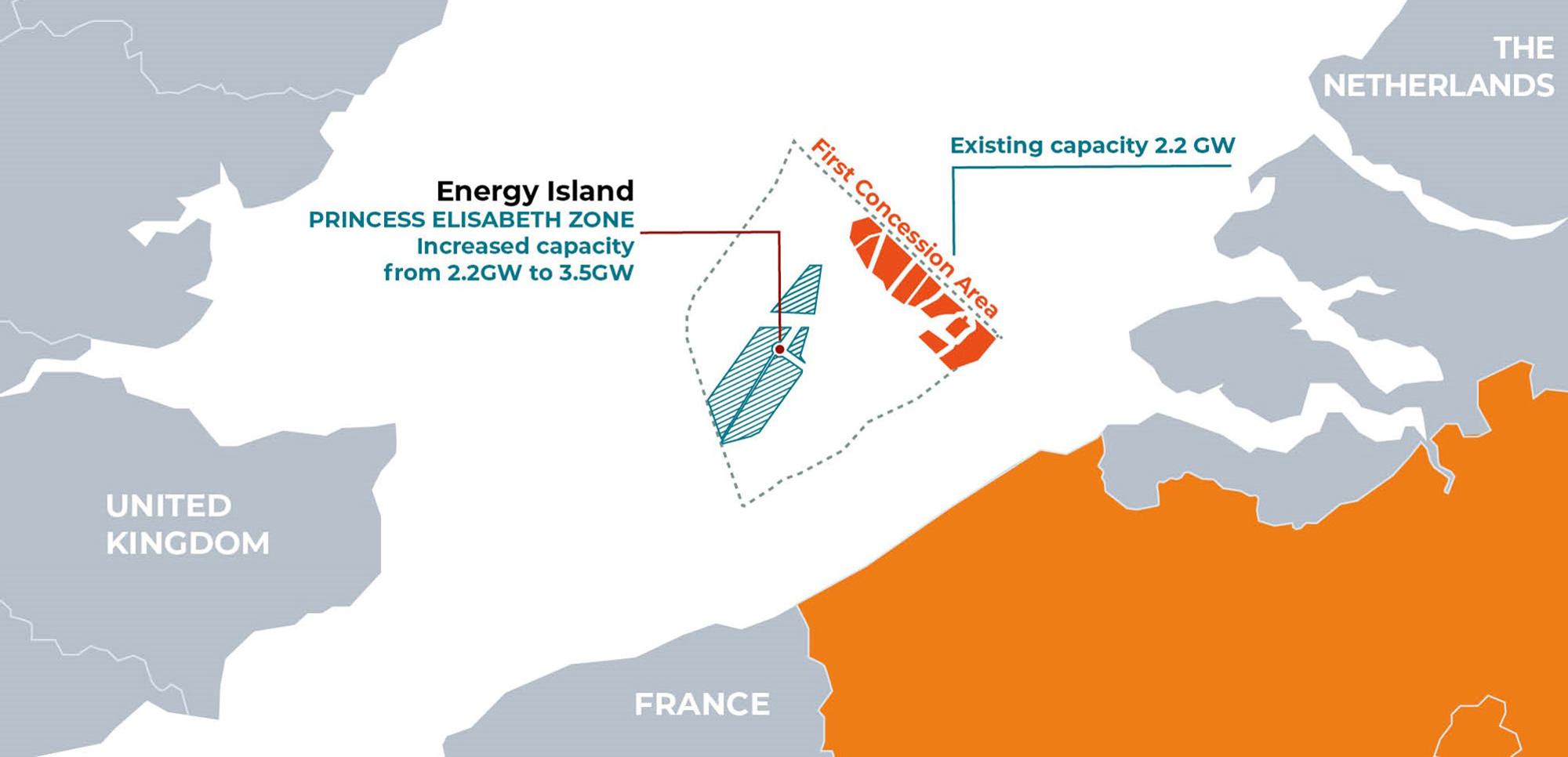The Princess Elisabeth Island
As the world’s first artificial energy island, the Princess Elisabeth Island is our flagship project. Located off the Belgian coast in the North Sea, the island will serve as an electricity hub that will bundle together the cables leading to wind farms in Belgium’s second offshore wind zone, helping to bring the electricity they generate back to shore. It will also act as an intermediate landing point for interconnectors that link Belgium to other European countries. Our teams have adopted a nature-inclusive design approach for the island: it has been designed in such a way that it will foster biodiversity and help marine life to flourish around it.

The cornerstone of a future integrated electricity grid at sea
The island will:
- be located 45 km off the Belgian coast in the middle of the Princess Elisabeth Zone - Belgium’s second offshore wind zone;
- stretch across an area of 6 hectares;
- have foundations, or caissons, built of concrete and filled with sand;
- host a small harbour and helipad so maintenance crews can access it;
- host both high-voltage direct current (HVDC) and alternating current (HVAC);
- encourage a rich ecosystem to thrive around it, thanks to its nature-inclusive design.
The island will therefore give Belgium access to offshore wind energy produced by wind farms in the Princess Elisabeth Zone: around 60 km of DC cables and 300 km of AC cables will be installed around it, bringing electricity back to the mainland. Moreover, given that it will serve as a landing point for interconnectors with other countries, it will allow Belgium to trade renewable energy with its neighbours and so enhance Europe’s interconnectedness.
The island will form the cornerstone of Europe’s future integrated offshore grid. Access to offshore renewable energy is seen as the foundation of the EU’s move to net zero. Connecting countries together via an offshore grid made up of hybrid interconnectors and energy hubs will allow the EU to secure its energy independence, facilitate its security of supply, and help it to become the first climate-neutral continent in the world.
Nature-inclusive design
We have adopted an innovative approach to the Princess Elisabeth Island, known as ‘nature-inclusive design’. We have been working with nature conservation experts and scientists to ensure that the way the island is designed has a positive impact on biodiversity and helps marine life to flourish. This means that both the island’s design and its function will be contributing to meeting the EU’s climate and biodiversity targets.
-
 Schedule
Schedule- 2022-2023: Tendering process for the energy island; development of the environmental impact assessment and permit procedure; and lodging of applications for the domain concession for the energy island.
- 2024 to mid-2026: Construction of the energy island, including the construction of the island’s caissons at Vlissingen (Netherlands) and offshore activities, including the levelling of the terrain and installation of the caissons.
- 2026-2030: Construction of electrical infrastructure on the energy island.
The development of wind farms in Belgium’s second offshore wind zone is aligned with the competitive procedure established by the Belgian government; the schedule for this can be accessed here. The connection of these offshore wind farms to Elia’s onshore grid is linked to the commissioning of the Ventilus and Boucle du Hainaut projects on the Belgian mainland. Elia aims to ensure that the wind farms will be fully connected to its onshore grid by 2030.
-
 In the interest of society
In the interest of societyThe island will be located in Belgium’s second offshore wind zone – the Princess Elisabeth Zone – which has an area of 285 km2 and was designated in Belgium’s 2020-2026 Maritime Spatial Plan. This zone will host new wind farms that will be able to produce up to 3.5 GW of wind energy.
Both Belgium’s first (2.3 GW) and second offshore wind zones will help Belgium to meet national and European climate ambitions: the EU is aiming to reach 300 GW of offshore wind energy capacity by 2050. This will help Europe reach net zero, supplying its citizens with affordable green energy and allowing it to reduce its reliance on energy imports.
-
 Environment
EnvironmentAs outlined in our sustainability programme,ActNow, we aim to preserve and strengthen ecosystems and biodiversity around our infrastructure. Dimension 2 of ActNow is linked to the UN’s fourteenth Sustainable Development Goal: Life Below Water.
We work hard to mitigate any potential negative impacts our projects and assets might have on the surrounding environment. As outlined in our application for the environmental permit for the Princess Elisabeth Island, we have gone one step further for this project: we have adopted a nature-inclusive design approach. This means that in addition to minimising harmful effects on the marine environment, the island will actually boost the ecological and environmental value of the area.
We led a co-creation process with our staff and nature conservation and marine environment experts, universities, consultancies and non-governmental organisations to design a unique set of nature-inclusive design measures that will enhance biodiversity and help marine fauna and flora to flourish around the island.
Find out more about nature-inclusive design here and in the video above.
The NID4BirdLIFE project
The NID4BirdLIFE project is a 6.5-year initiative co-financed by the LIFE Programme, the European Union's funding instrument for environment and climate action. The project aims to address the critical decline of the black-legged kittiwake (Rissa tridactyla) population by creating a durable breeding stronghold on the Princess Elisabeth Energy Island. This will be achieved through the integration of Nature-Inclusive Design (NID) elements into the island's wave walls.
The Princess Elisabeth Island, located off Belgium’s North Sea coast, will be the world's first energy island. It will serve as an electricity hub, bundling together the cables of the surrounding offshore wind farms in order to bring the power generated to land. It will also act as a landing point for the interconnectors between Belgium and other European countries. For its construction, an innovative approach which included 'nature-inclusive design' (NID) was embraced. In collaboration with experts in nature conservation, marine restoration and ecology, Elia developed specific measures to enhance biodiversity and support marine life around the island. For a comprehensive overview of NID, discover this page. -
 Offshore infrastructure
Offshore infrastructure -
 Support from the European Recovery Fund
Support from the European Recovery FundThe energy island uses the European Recovery Fund, which is intended to provide the Belgian economy with additional incentives through future-oriented initiatives. Investing in infrastructure is investing in economic growth that strengthens the socio-economic prosperity of our country.

-
 Documents
DocumentsAnnexes Milieueffectenrapport MOG2
Environmental permit (in Dutch)
Project voor de uitbreiding van het transmissienet op zee (in Dutch)
Brochure "Transforming our seas into Europe sustainable economic engine"
Brochure "Princess Elisabeth Island - Nature Inclusive Design
News

19 June 2024
Elia Transmission Belgium concludes HVAC cable and substation contracts for Princess Elisabeth Island

23 April 2024
Government delegation highlights Belgium's pioneering role and expertise in offshore wind during visit to impressive caisson construction site for Princess Elisabeth Island

13 November 2023



